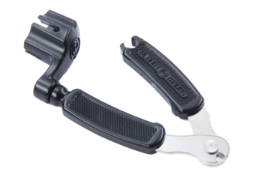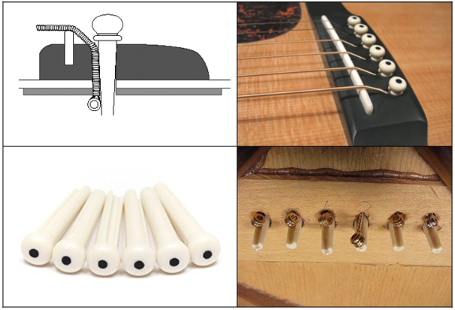by Sandi Millar/Chuck Millar from Lesson Pros
Acoustic guitars are generally fitted with steel strings, while traditional classical guitars are generally fitted with nylon strings. In this blog article, we’ll explain how to change the steel strings on an acoustic guitar.
How do I Determine What Strings to Buy?
While there are many different brands of steel acoustic guitar strings out there today that all have a variety of gauges. Here is what we use: Chuck uses Elixir Medium Nanoweb Phosphor Bronze on his CW28 Clarence White guitar, while Sandi uses Elixir Custom Light Nanoweb Phosphor Bronze on her D45V Martin guitar. (see picture)
Here is a list of other strings that we have tried and really like:
Martin MSP4150 SP Phosphor Bronze Acoustic Guitar Strings
D’Addario EJ16 Phosphor Bronze Guitar Strings
Elixir 80/20 Bronze Medium Nanoweb Acoustic Guitar Strings, NANOWEB Coating
Ernie Ball 2146 Earthwood Phosphor Bronze Acoustic Guitar Strings
John Pearse 600 L Phosphor Bronze Acoustic Guitar Strings
What does gauge mean?
String gauges can range from extra light to extra heavy. Most of the time, the 6, 5, 4, and 3rd strings are wound, while usually, the 1 and 2 strings in a set are not wound. Gauge is an important element for both the tone and how easily the guitar plays. If the strings are really light, the guitar will most likely be easier to play, but you may have to sacrifice some sound with the lighter strings. The heavy strings are going to be, in general, harder to play, but you will get a louder sound in most cases. If you are just getting started, you will most likely want to use lighter strings. (see example)
How to change your guitar strings
#1 - Get a Strings Winder or Pickers Pal
This is a tool to help you wind the strings faster than by hand. Some of them come with all the parts you need to change your strings, such as a winder, clipper, and peg puller—the all-in-one tool. (See picture.) It is not necessary to have a string winder/picker pal, but it makes tuning your guitar so much easier and a lot faster, too.
#2 - Taking the Strings Off - 3 at a Time
We suggest taking three strings off at a time. Here is why: When you take off all the strings at once, it changes the tension on the neck, which can cause minor or major problems with your guitar neck. However, if you need to clean your guitar fingerboard, it is much easier to do this with all the strings off. We always wipe our fingerboard down but still keep three strings on unless the neck is really bad, in which case we will take all the strings off.
#3 - How to Remove the Bridge Pin that is Holding the String
Typically, you will want a peg puller, which is generally located on a string winder. Be careful not to push it back and down, which will most likely hit the guitar body and put a bend in it. Trust us, we both have done that before. If you are still having trouble getting the peg out, you may have to stick your hand through the sound hole and push it up from inside of the guitar body. Sometimes we have to use a fork because you can stick the point of the fork into the slot of the bridge pin. This doesn’t always work, but if you are desperate, it is worth a try.
#4 Fitting the String into the Bridge
When you pull the old string out of the bridge, you will notice a ball on the end of the string. This is the case with all steel strings. The bridge pin helps hold the ball in place. Once you stick the ball into the hole of the bridge, put the bridge pin in, then pull the string so there is no extra slack. Be sure to push the bridge pin in and apply a little bit of pressure, making sure the pin is tight. (see pictures) Here is an important tip: before tuning your strings up, be sure the bridge pin is tight enough. We have had the pins shoot out like a rocket while tuning up the string. Trust us; you don’t want to lose an eye or hurt anyone else who might be sitting across from your guitar while you are tuning it.
#5 - How to Fit the String into the Tuning Machine/Tuning Peg
You will notice on your headstock (this is where the tuning machines are located) that there are the tuners and the posts. (see picture) Take the other end of the string and put it through the little hole where the post is sticking up. The string is coiled 3 to 4 times around the post. We would suggest that you make sure the string coils don’t overlap and start coiling from top to bottom. (see picture) How you can figure out a rough distance by spreading your hand out up and down between the fingerboard and the loose string (this is a general guideline). Over time, you will be able to gauge this distance better.
#6 - How do I Tell Which Way to Wind the Strings?
It is very important that you wind the strings the correct way. The strings should always be on the inside of the headstock. So if you wound them and they are on the outside of the tuning pole, be sure you make this correction. (see picture)
#7 - How to Tune Your Guitar
Once all the strings are on, you will want to ensure the guitar is in tune. If you have not done this before and are trying to tune by ear, it is a great idea to ask someone for help. We highly recommend an electronic tuner. (see picture) Once you have your strings in tune, they will continue to stretch. It is a good idea to try to stretch them yourself by pulling up and down on the strings (see picture) and then returning. We usually do this a couple of times until the strings settle in.
#8 - Cutting off the ends
Now that your guitar strings are fitted, stretched, and tuned, it is time to cut off the ends of each string. You can use a wire cutter, or, as mentioned above, some string winders have the wire cutter right on them. This will clean up the look of the headstock.
How Often Should I Change My Strings?
That depends on whether you like how they sound and/or if they respond the way you want them to. Some guitarists have very oily hands, so they will likely need to change their strings more often. We have a guitarist friend who changes his strings before every show. If he has three shows in a day, he changes them three times daily, which is ridiculous, but if that is what he wants to do, he should. We change our strings about once every couple of months. If we are playing many shows, we will change them about once a month.
We teach our students to change their strings when the strings start to look worn. The strings will get brown tarnished spots, start to sound dull, and/or you can’t keep your guitar in tune. So a recommendation is about every 4-6 months for beginner guitar players, unless you are playing all the time, then maybe more. We also recommend you try out different kinds of strings. You will find that some last longer than others. There is no hard-set rule on how often to change your strings.
We hope you found these tips on how to change your acoustic guitar strings helpful.
Lesson Pros
If you are interested in learning to play an instrument, check out our Guitar Courses or All Lesson Pros Courses.









